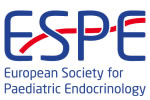hrp0095p1-93 | Fetal, Neonatal Endocrinology and Metabolism | ESPE2022
Measurements of Growth Hormone in neonatal screening cards as a non-invasive and feasible tool: reference values in healthy term newborns.
Giacchetti Federico , Vidali Matteo , Sangiorgio Andrea , Rodari Giulia , Vantaggiato Chiara , Modugno Adriana Di , Morniroli Daniela , Colombo Lorenzo , Profka Eriselda , Dall'Antonia Alberta , Collini Valentina , Ceriotti Ferruccio , Mosca Fabio , Arosio Maura , Lorella Giannì Maria , Giavoli Claudia
hrp0097p1-86 | Fetal, Neonatal Endocrinology and Metabolism | ESPE2023
Measurements of Growth Hormone using dried blood spots in preterm neonates: reference values and longitudinal evaluation.
Federico Giacchetti , Orsenigo Chiara , Vizzari Giulia , Tarricone Silvia , Vantaggiato Chiara , Rodari Giulia , Napolitano Filomena , Sangiorgio Andrea , Morniroli Daniela , Colombo Lorenzo , Profka Eriselda , Collini Valentina , Risio Alessandro , Lorella Giannì Maria , Arosio Maura , Mantovani Giovanna , Mosca Fabio , Ceriotti Ferruccio , Vidali Matteo , Giavoli Claudia
hrp0089p1-p211 | Pituitary, Neuroendocrinology and Puberty P1 | ESPE2018
Effect of Pubertal Blockade and Cross-sex Hormone Treatment on the Growth Spurt in Young Transgender Adolescents: A First Report
Catanzano Matteo , Butler Gary
hrp0095p1-196 | Thyroid | ESPE2022
Diffuse Sclerosing Variant of Papillary Thyroid Cancer in a boy with Goldenhar Syndrome
Ferrari Marta , Cerutti Matteo , Ricci Franco , Stagi Stefano
hrp0097fc11.3 | GH and IGFs | ESPE2023
Analysis of a large panel of genes in a cohort of patients with severe short stature: detection rate and genotype-phenotype correlations
Guazzarotti Laura , Mozzato Chiara , Meneghin Alice , Nicolucci Antonio , Cassina Matteo
hrp0089p2-p266 | Growth & Syndromes P2 | ESPE2018
A Novel FGFR1 Mutation in Kallmann Syndrome with Growth Hormone Deficiency
Tornese Gianluca , Pellegrin Maria Chiara , Pavan Matteo , Faleschini Elena , Barbi Egidio
hrp0086p2-p663 | Growth P2 | ESPE2016
A Case of GH Deficiency in a Female with 3M Syndrome
Bortone Barbara , Scalini Perla , de Martino Maurizio , Giglio Sabrina , Lapi Elisabetta , della Monica Matteo , Stagi Stefano
hrp0086p1-p818 | Syndromes: Mechanisms and Management P1 | ESPE2016
Haploinsufficiency of Short Stature Homeobox Containing Gene: Clinical Signs and Anthropometric Measurements in Children
Genoni Giulia , Monzani Alice , Castagno Matteo , Giordano Mara , Prodam Flavia , Bellone Simonetta , Bona Gianni
hrp0082fc3.6 | Diabetes | ESPE2014
Alpha-Lipoic Acid and Anti-Oxidant Diet Helps to Improve Endothelial Dysfunction in Children and Adolescents with Type 1 Diabetes
Scaramuzza Andrea , Ungheri Saverio , Redaelli Francesca , Bosetti Alessandra , Giani Elisa , Ferrari Matteo , Comaschi Valentina , Giudici Valentina , Zuccotti Gian Vincenzo
hrp0084p2-417 | GH & IGF | ESPE2015
GH Therapy in Skeletal Dysplasias: Final Height Data
Scarano Emanuela , Procopio Matteo , Tamburrino Federica , Perri Annamaria , Bettocchi Ilaria , Vestrucci Benedetta , Rollo Alessandra , Balsamo Antonio , Mazzanti Laura



